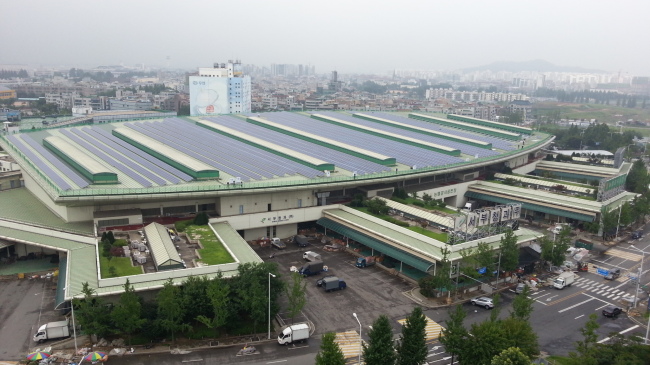The capital of South Korea is getting greener amid the city government’s continuous efforts for a sustainable future with its three flagship projects.
Seoul Metropolitan Government has run the campaign “One Less Nuclear Power Plant” since 2012 to reduce the energy dependence on nuclear power by developing renewable energy sources.
Having few options for alternative sources, South Korea depends on nuclear power for 31 percent of its energy needs, according to government statistics. The capital’s energy self-sufficiency rate also remains at 2.95 percent.
With a goal of cutting energy consumption by 2 million TOE (tons of oil equivalent) by 2014, the city expanded the number of mini solar power plants installed at houses and offices, and replaced indoor light bulbs with energy-efficient LEDs.
 |
This photo shows a 1.2-megawatt solar power plant constructed in 2013 at Gangseo farmers market in western Seoul. (Seoul Metropolitan Government) |
The city also carried out the Eco Mileage program, which offers incentives to those who save electricity. More than 1.5 million citizens have actively joined the program so far.
As a result, energy consumption in Seoul decreased by 2.04 million TOE six months earlier than expected, and the greenhouse gas emissions fell by 5.6 million tons. The energy self-supply rate also rose to 4 percent last year, the city said.
Seoul City is now pushing to offset carbon emissions by 20 million tons by 2030, which would be a 40 percent decline compared to 2005, while eyeing to increase the energy self-sufficiency rate to 20 percent by 2020.
Along with the flagship energy-saving project, the city has been carrying out a large-scale public transportation campaign since 2004 to attract more passengers to use buses and subway.
The city constructed bus lanes across the capital to offer faster travel. It also introduced a public transfer system which allows passengers to transfer between buses and the subway lines without extra charges.
For better air quality, the city replaced some 7,000 diesel-powered buses with compressed natural gas-fueled buses.
In the meantime, the capital is planning to construct 10 light rail lines to reduce blind spots in its subway and bus network by 2025, the city said.
Along with energy-saving plans and the transportation scheme, the urban regeneration project is another flagship policy of Seoul City for a sustainable future.
The capital is attempting to provide tailored urban development measures based on the characteristics of each region for sake of sustainability. It is seeking to transform 27 regions in the capital into specialized areas under specific themes.
For example, an old industrialized region Janganpyeong in eastern Seoul will turn into an environment-friendly town by 2017. By constructing the country’s first-ever upcycling center ― a 16,500-square-meter building for green start-ups and recyclable material sales ― the city will promote the culture of reusing, recycling and upcycling. The existing used car market and water sewage museum in the region will also be used for this purpose, the city said.
About 1.3 trillion won ($1.2 billion) is to be injected in the overall urban regeneration project, it added.
By Lee Hyun-jeong (
rene@heraldcorp.com)




![[Today’s K-pop] Blackpink’s Jennie, Lisa invited to Coachella as solo acts](http://res.heraldm.com/phpwas/restmb_idxmake.php?idx=644&simg=/content/image/2024/11/21/20241121050099_0.jpg)



